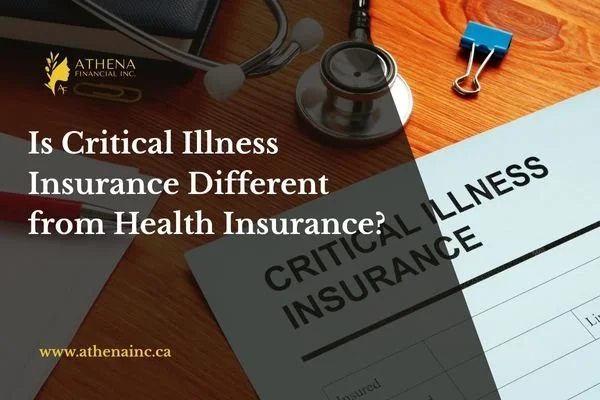Is Critical Illness Insurance Different from Health Insurance?
Have you ever stopped to consider what a serious illness would actually cost you? Most people instinctively point to their health insurance card, secure in the knowledge that they have "coverage." They picture hospital beds, surgical bills, and doctor fees being handled by their comprehensive plan. The truth is, while essential, standard health coverage is designed to cover the medical treatment. It is rarely built to protect your income and your life savings when a major diagnosis—like cancer, a stroke, or a heart attack—stops your working life cold. This leads to one of the most common and expensive misunderstandings in personal finance: the difference between Health Insurance and Critical Illness Insurance.
Many people operate under the mistaken belief that one replaces the need for the other. They do not. In fact, they are two separate, distinct components of a successful financial defense strategy.This guide will break down the crucial distinctions between these two forms of protection, illustrate the powerful role of a Critical Illness policy, and explain how getting the right advice is key to bridging your financial gap during a health crisis.
Key Takeaways
Lump Sum vs. Reimbursement: Health insurance pays the hospital/doctors via reimbursement; Critical Illness Coverage pays a lump sum of cash directly to you.
The Coverage Gap: Health insurance covers the medical bills; Critical Illness Coverage covers everything else—lost income, mortgage payments, childcare, and specialized recovery expenses.
A Financial Shield: The payout from a Critical Illness policy is flexible, allowing you to use it to protect your family’s lifestyle, pay down debt, or seek non-covered treatments.
They Are Not Interchangeable: You need both. Health coverage is your first line of defense; a policy covering a major sickness is your backup to safeguard your wealth and income.
Overview
A major health crisis presents two financial threats: the immediate cost of care and the long-term cost of being unable to work. Your Health Insurance policy is specifically crafted to tackle the first threat. It functions on an indemnity basis, meaning it promises to "make you whole" by paying or repaying the medical providers for covered services.
A policy protecting you from a major sickness, on the other hand, is a different financial tool entirely. It is a fixed-benefit policy, which means the insurer pays out a pre-agreed-upon sum—often six figures—regardless of the actual medical bills. This money is designed to combat the second, often more devastating threat: the interruption of your ability to earn a living.
The Defining Difference: Payout Mechanism and Financial Focus
The heart of the confusion lies in the way money moves. Understanding this distinction is vital to appreciating the necessity of both policies.
The Mechanism of Health Insurance
Health insurance operates like a financial goalkeeper for your medical expenses.
Focus: The Provider’s Bills
When you use your health plan, the payout process is typically:
Service Rendered: You receive treatment (surgery, hospital stay, lab work).
Bill Submission: The medical provider submits the bill to your insurance carrier.
Adjudication: The insurer reviews the bill, applies your deductible, co-pays, and co-insurance, and determines the "allowable amount" based on their network agreements.
Reimbursement/Payment: The insurer pays the covered portion directly to the provider. You are responsible for the rest.
Your plan controls where the money goes (to the doctors) and what it is spent on (covered procedures). The primary purpose is to stop medical debt from crushing you due to the high expense of treatment. If you are diagnosed with a major illness, your health coverage may cap out or exclude certain cutting-edge or experimental treatments, leaving you with hefty out-of-pocket expenses even for approved care.
The Mechanism of Critical Illness Insurance
A policy providing coverage for a major sickness, like Critical Illness Insurance, operates as a cash injection for your family's recovery and living expenses.
Focus: Your Family’s Wallet
The payout process is straightforward and hands the control to you:
Diagnosis: A physician confirms you have one of the serious conditions specifically listed in your policy (e.g., specific heart attack, advanced cancer, stroke).
Claim Filing: You file a claim with the diagnosis report.
This cash is then yours to use, with no restrictions. It does not need to be spent on medical bills. It is the ultimate financial buffer, protecting the foundation of your family's economic stability while you concentrate on healing.
Bridging the Gap: What Health Insurance Doesn't Cover
The true value of an insurance plan that covers a major sickness becomes apparent when you consider the expenses that standard medical coverage leaves untouched. A major diagnosis can trigger a financial cascade that traditional insurance is simply not structured to handle.
The Cost of Lost Income
The most significant financial impact of a serious illness is often not the hospital bill, but the loss of income. A successful recovery from a major heart event or a cancer treatment protocol could easily require six months to a year away from work, or even necessitate an early career change or retirement.
Example: A breadwinner is diagnosed with a severe stroke. Health insurance covers the lengthy hospital and rehabilitation center stays. But the family loses $10,000 a month in salary. The CI lump sum immediately replaces that income stream, allowing the family to pay the mortgage, utilities, and grocery bills without burning through their retirement savings or going into debt.
Out-of-Pocket Medical Costs
Even with good health insurance, the out-of-pocket costs for a major illness can be staggering. You will face:
Deductibles and Co-pays: These restart every year and can amount to thousands of dollars.
Non-Covered Specialists: Seeking out the best doctors or a new clinical trial that is outside your network or deemed "experimental."
Specialized Recovery: Costs for in-home nursing care, physical therapy beyond plan limits, or necessary medical equipment purchased for the home.
The funds provided by Critical Illness Insurance offer a clean, liquid source of cash to cover every penny that your primary health plan leaves behind.
The Hidden Costs of Recovery
Serious illness dramatically alters a family's day-to-day life, imposing costs that are purely non-medical:
Travel and Accommodation: Paying for a spouse to stay near the hospital, or flying to a specialized treatment center across the country.
Childcare/Eldercare: Hiring help when the primary caregiver is sick or the patient needs full-time supervision.
Debt Servicing: The ability to pay off or significantly pay down high-interest debts, removing stress and freeing up monthly cash flow when income is precarious.
A comprehensive financial strategy acknowledges that financial recovery is just as important as medical recovery.
Implications and Perspectives: Who Needs Critical Illness Protection?
Given the escalating costs of medical treatment and the instability of employment during a health crisis, the question is not "Who needs this?" but "Who can afford not to have it?"
The Vulnerability of the Middle Class
People with high net worth often have the liquid assets to self-insure against lost income. Those with lower incomes may qualify for extensive government or social assistance programs. The most financially vulnerable group is often the middle class—the working professional or the small business owner.
This group typically has:
Significant Debt: Mortgages, car payments, and student loans tied to current income.
Limited Savings: A majority of wealth is tied up in home equity or retirement funds that are difficult and expensive to access early.
For a middle-class family, a major diagnosis without Critical Illness Insurance can turn a medical emergency into an immediate, devastating bankruptcy. The lump sum is a firebreak, preserving their wealth while their health coverage manages the hospital bills.
The Importance of Policy Specificity
It is crucial to understand that an insurance policy designed to cover a major sickness is highly specific. Unlike health insurance, which covers virtually any sickness, a CI policy will only pay out if the condition meets the exact, detailed definition in the contract.
For instance, a policy may only pay out for "Advanced-Stage Cancer" or a "Severe Heart Attack" as defined by specific medical markers. Consulting a financial professional is not merely beneficial—it is essential to evaluate the list of covered conditions, understand the definitions, and select a policy that provides genuinely meaningful protection against the most common and expensive serious illnesses. A do-it-yourself approach in this area can lead to a false sense of security.
Your Next Step in Financial Protection
The journey to complete financial security begins with acknowledging that Health Insurance and an insurance plan covering a major sickness are not rivals; they are allies. They work in tandem, with one covering the cost of treatment and the other defending your home, your income, and your peace of mind.
To evaluate your risk profile and select a plan that precisely meets your family’s needs, professional guidance is indispensable. DIY solutions often overlook critical policy details and coverage gaps that can leave you exposed when it matters most.
Ready to build a complete defense for your financial health? Athena Financial is here to help you get the right Critical Illness Insurance coverage that will protect your family's future, no matter what comes next. Contact us at 604-618-7365 for an individual assessment.
FAQs
Q: Can I use my Critical Illness payout to pay my rent or mortgage?
A: Absolutely. The payout is a lump sum paid directly to you, the policyholder, with no restrictions on how it is spent. Most people use it for non-medical expenses like rent, mortgage payments, or to replace lost income.
Q: Does a Critical Illness policy replace my regular Health Insurance?
A: No. Critical Illness coverage does not cover routine medical procedures, doctor visits, or general hospitalization for minor illnesses. It is a supplementary policy that provides cash for serious illnesses while your Health Insurance continues to handle your day-to-day medical bills.
Q: What is the "survival period" in Critical Illness Insurance?
A: The survival period is a short timeframe (often 14 or 30 days) that the policyholder must survive after the diagnosis of a covered critical illness for the lump-sum benefit to be paid out. This is a common stipulation in these types of policies.
Q: Why would I need a lump sum if my medical bills are covered?
A: The lump sum is for non-medical costs, such as the income lost from being out of work, hiring a caregiver, paying your health plan’s deductible, or covering travel expenses for specialized treatment. It defends your savings account and lifestyle, not just your hospital account.
Conclusion: The Two Pillars of Health Finance
In the complex landscape of personal finance, relying on a single insurance policy for comprehensive protection is risky. Health insurance is the essential first pillar, ensuring access to quality medical care without generating crippling debt. Critical Illness Insurance is the second, equally vital pillar, shielding your household income and accumulated wealth from the financial earthquake that follows a major diagnosis.
By understanding that one handles the hospital's ledger and the other secures your family’s future, you move beyond mere coverage to genuine security. Don't leave your long-term finances to chance when facing the most difficult health challenges. Take control of your defense strategy now.

